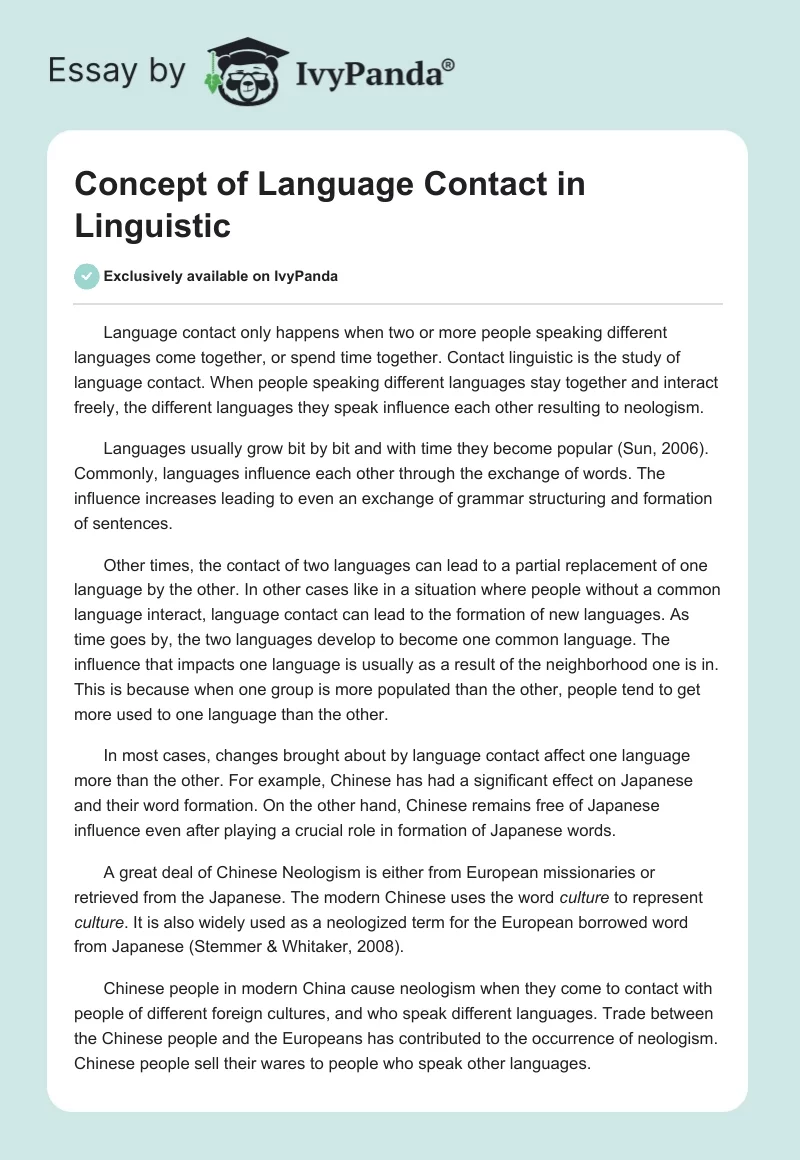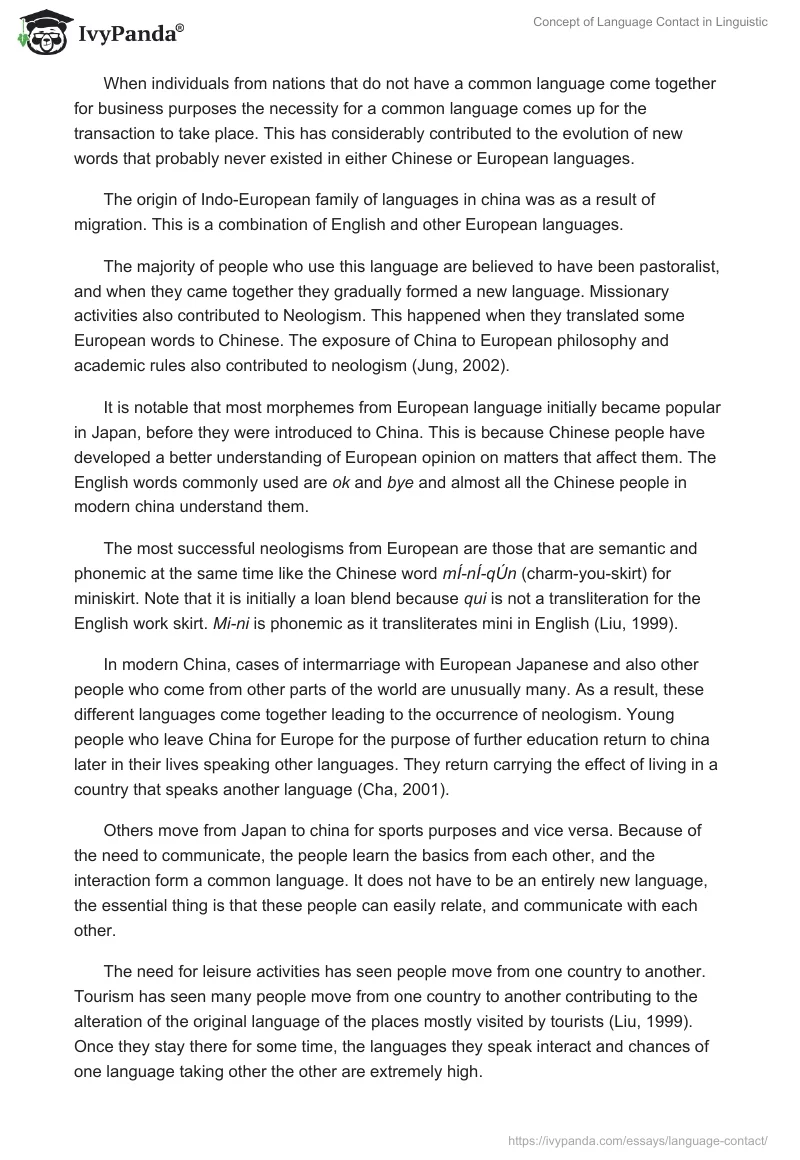Language contact only happens when two or more people speaking different languages come together, or spend time together. Contact linguistic is the study of language contact. When people speaking different languages stay together and interact freely, the different languages they speak influence each other resulting to neologism.
Languages usually grow bit by bit and with time they become popular (Sun, 2006). Commonly, languages influence each other through the exchange of words. The influence increases leading to even an exchange of grammar structuring and formation of sentences.
Other times, the contact of two languages can lead to a partial replacement of one language by the other. In other cases like in a situation where people without a common language interact, language contact can lead to the formation of new languages. As time goes by, the two languages develop to become one common language. The influence that impacts one language is usually as a result of the neighborhood one is in. This is because when one group is more populated than the other, people tend to get more used to one language than the other.
In most cases, changes brought about by language contact affect one language more than the other. For example, Chinese has had a significant effect on Japanese and their word formation. On the other hand, Chinese remains free of Japanese influence even after playing a crucial role in formation of Japanese words.
A great deal of Chinese Neologism is either from European missionaries or retrieved from the Japanese. The modern Chinese uses the word culture to represent culture. It is also widely used as a neologized term for the European borrowed word from Japanese (Stemmer & Whitaker, 2008).
Chinese people in modern China cause neologism when they come to contact with people of different foreign cultures, and who speak different languages. Trade between the Chinese people and the Europeans has contributed to the occurrence of neologism. Chinese people sell their wares to people who speak other languages.
When individuals from nations that do not have a common language come together for business purposes the necessity for a common language comes up for the transaction to take place. This has considerably contributed to the evolution of new words that probably never existed in either Chinese or European languages.
The origin of Indo-European family of languages in china was as a result of migration. This is a combination of English and other European languages.
The majority of people who use this language are believed to have been pastoralist, and when they came together they gradually formed a new language. Missionary activities also contributed to Neologism. This happened when they translated some European words to Chinese. The exposure of China to European philosophy and academic rules also contributed to neologism (Jung, 2002).
It is notable that most morphemes from European language initially became popular in Japan, before they were introduced to China. This is because Chinese people have developed a better understanding of European opinion on matters that affect them. The English words commonly used are ok and bye and almost all the Chinese people in modern china understand them.
The most successful neologisms from European are those that are semantic and phonemic at the same time like the Chinese word mÍ-nÍ-qÚn (charm-you-skirt) for miniskirt. Note that it is initially a loan blend because qui is not a transliteration for the English work skirt. Mi-ni is phonemic as it transliterates mini in English (Liu, 1999).
In modern China, cases of intermarriage with European Japanese and also other people who come from other parts of the world are unusually many. As a result, these different languages come together leading to the occurrence of neologism. Young people who leave China for Europe for the purpose of further education return to china later in their lives speaking other languages. They return carrying the effect of living in a country that speaks another language (Cha, 2001).
Others move from Japan to china for sports purposes and vice versa. Because of the need to communicate, the people learn the basics from each other, and the interaction form a common language. It does not have to be an entirely new language, the essential thing is that these people can easily relate, and communicate with each other.
The need for leisure activities has seen people move from one country to another. Tourism has seen many people move from one country to another contributing to the alteration of the original language of the places mostly visited by tourists (Liu, 1999). Once they stay there for some time, the languages they speak interact and chances of one language taking other the other are extremely high.
For a person whose origin is Europe working in China, he/she has to learn Chinese. In this case, because of his European origin, some altered Chinese terms produce entirely new terms, but with a meaning. At times, the need for a new name to describe something leads to a development or borrowing of words from other languages.
References
Cha, T. H. K. (2001). Dictée. Berkeley, Calif. [u.a.: Univ. of California Press.
Jung, H. Y. (2002). Comparative political culture in the age of globalization: An introductory anthology. Lanham [u.a.: Lexington Books.
Liu, L. H. (1999). Tokens of exchange: The problem of translation in global circulations. Durham, N.C: Duke Univ. Press.
Stemmer, B., & Whitaker, H. A. (2008). Handbook of the neuroscience of language. Amsterdam: Elsevier/Academic Press.
Sun, C. (2006). Chinese: A linguistic introduction. Cambridge [u.a.: Cambridge Univ. Press.


